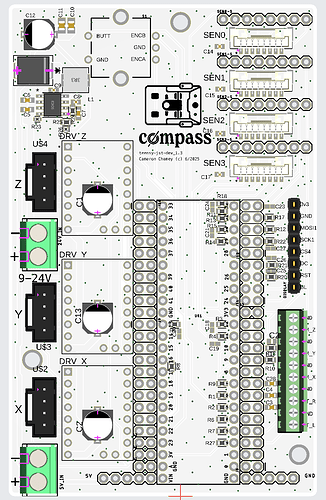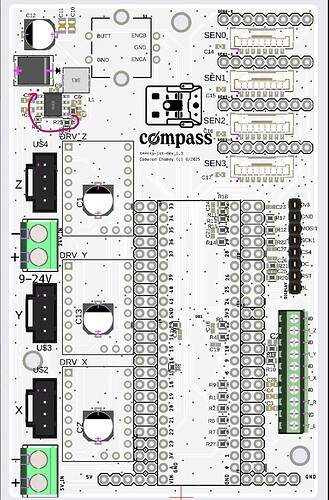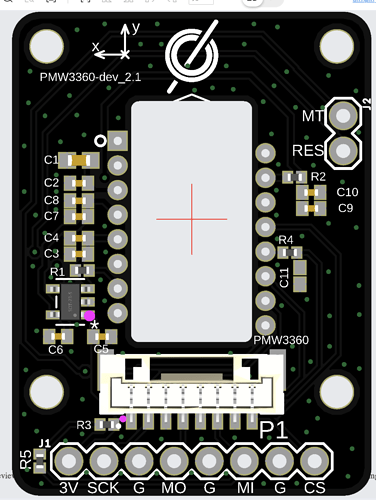I’m very interested in a PCB kit as well. I’m sure many others here also have most of the components needed besides the custom boards and aluminum plates.
Okk just published the PCB kit:
Came out to a little more than I was expecting. Forgot to include tariffs on that initial estimate ![]()
Ordering in the next day or two, so the lead-time should be around 1-2 weeks.
Thanks for the update! Just to clarify—when you say not all of the components populate in the correct orientation, are there specific parts I should double-check more carefully?
Also, since this is my first time doing this: what’s the best way to verify that all components are placed in the correct orientation and position? Is there a visual reference or template I can use to double-check the layout before assembly?
The small IC, polarised caps and stepper connectors needed adjusting for me
Thanks, Picklez, for the helpful reply!
Would it be possible for you (or anyone else) to share a photo of the JLCPCB order showing the component placements?
I’m especially interested in the positioning of the small IC, the polarized capacitors, and the stepper connectors. That would help a lot!
Thanks in advance ![]()
Here’s a photo of my current setup for reference.
It might help show what adjustments I had to make or what’s still unclear.
Any feedback is welcome!
Just for me – and maybe for others as well – and to wrap this topic up:
Regarding the PMW3360 PCB , apart from rotating the SOT-23-5 by 180 degrees, is there anything else to watch out for with the other components?
Huge thanks to Picklez for your support, and greetings from Hamburg!
I haven’t looked at this pcb in detail, but just look at this with my electronics manufacturing experience:
The footprints for the capacitors and resistors look too big to me for the parts used. The footprints look for example like footprints optimized for hand soldering.
When you use this kind of footprint for reflow soldering instead, there is a steep increase of probabilty that tombstoning happens. The solder paste melts at a slightly different point in time on the two sides. The surface tension gets larger depending on pad size. The side that melts first now exerts it’s surface tension on the part and that can lift up the part from the other side that is not yet melted.
So I suggest to either increase the part sizes or decrease the footprint sizes. The latter is probably cheaper when you target PCBA-services like JLC, because the smaller parts are often more common.
Just to be clear, I meant the screenshot of the PMW3360 PCB as shown by JanOetjen.
Hi there!
First of all, thank you for making this project open source—it looks fantastic! I’ve ordered all the hardware components and, as a mechatronics engineer, I have a few suggestions to improve the PCB design. I would be happy to assist if you share the project files.
-
The pads for the SMD components appear to be oversized, even larger than those for hand soldering. This could lead to assembly issues.
-
While the specified model of the step-down regulator is functional, I would recommend considering alternatives for this application. The current model requires some unusual resistors and capacitors, which can increase the cost of the assembled board—especially since JLCPCB charges extra for parts from their extended library. A better option might be the TS2596CM550, which is affordable, readily available, and only requires standard components. Though the TPS54360 supports input voltages up to 60V, 40V should suffice for most applications.
-
I suggest using Molex JST XH insted of the pin headers. There are many very cheap copies available in the JLCPCB library, and they are considered an industry standard. They allow for easy sourcing of cables and would be a more effective solution than pin headers for this purpose.
-
For power connections, I recommend using Phoenix Contact MC 3.81/3.5 series connectors. These are also widely available in the JLCPCB library at a low cost (copies) and are common in the industry.
-
Are you using UART or SPI for the Teensy 4.1 and TMC2009 communication? Implementing sensorless homing can reduce the need for additional cables, and using UART provides numerous advantages, such as the ability to adjust the stepper motor’s amperage through software.
Best regards!
Hmm yeah it’s weird they do seem big. This is just the standard 0402 footprint for the capacitor library I used. Must be made for hand soldering. I just switched the library for all the parts on the sensor board and the footprints are much smaller. I’ll be using this for manufacturing and will upload the files to the repo soon.
Awesome, thanks for all the suggestions and excitement for the project!
That sounds pretty solid. Being able to accept 48V could be a good options to have for future upgrades, but I will definitely consider it.
Are you referring to the display header? Yeah, I’m definitely planning on switching this at some points. But for now it’s easier to be able to use dupont connectors so that you can use a variety of different off-the-shelf displays with different pinouts.
UART yeah. Sensorless homing is definitely on the to-do list! Just have a few higher priority things to get to first ![]()
oooh i’ll have a limited edition chonky pad one, my PCBs are in the post ![]()
Hahah lucky duck. They will be fine. I’ve been using chonky pads for the past ~100 sensor boards I made


